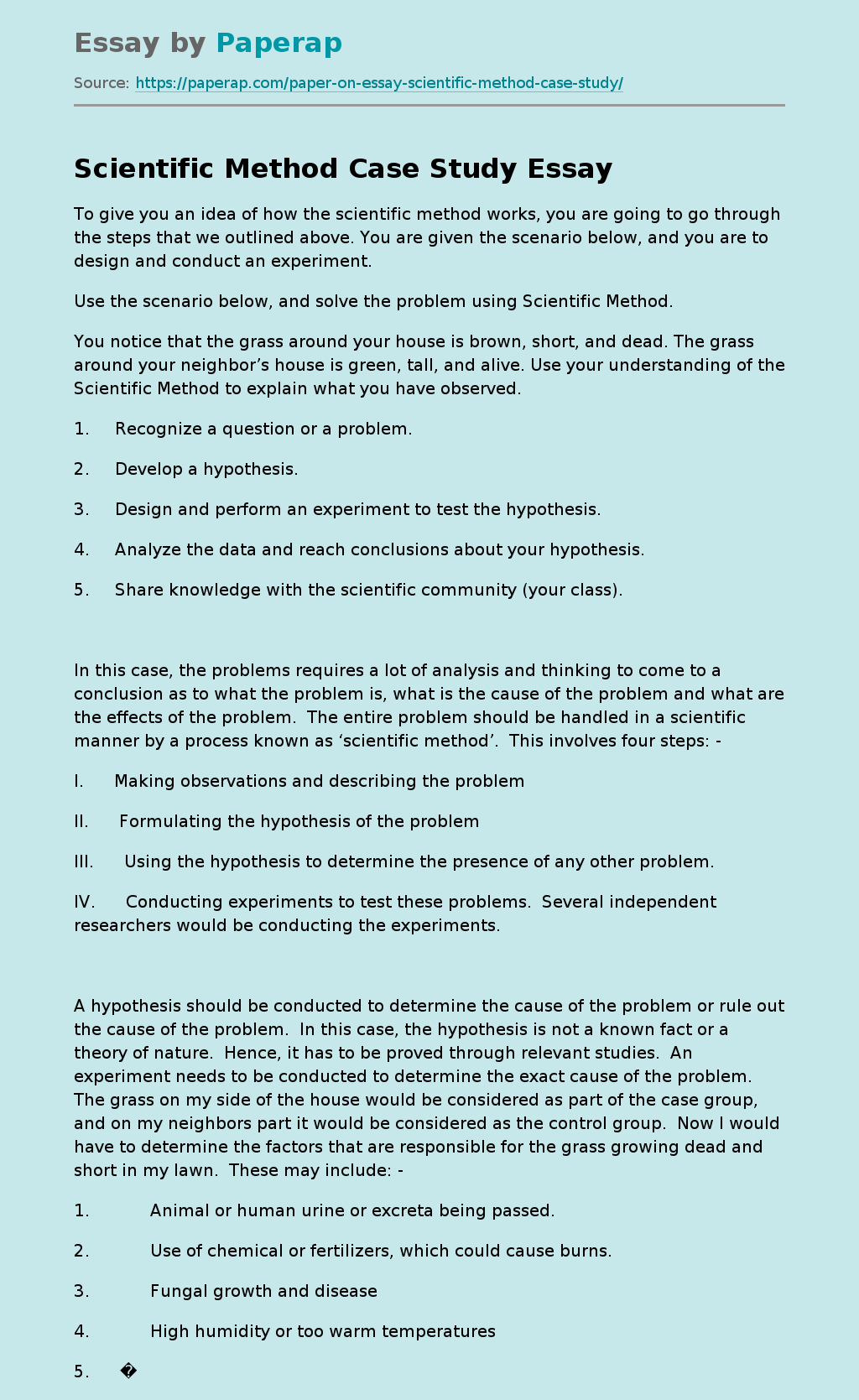Scientific Method Case Study
To give you an idea of how the scientific method works, you are going to go through the steps that we outlined above. You are given the scenario below, and you are to design and conduct an experiment.
Use the scenario below, and solve the problem using Scientific Method.
You notice that the grass around your house is brown, short, and dead. The grass around your neighbor’s house is green, tall, and alive. Use your understanding of the Scientific Method to explain what you have observed.
1. Recognize a question or a problem.
2. Develop a hypothesis.
3. Design and perform an experiment to test the hypothesis.
4. Analyze the data and reach conclusions about your hypothesis.
5. Share knowledge with the scientific community (your class).
In this case, the problems requires a lot of analysis and thinking to come to a conclusion as to what the problem is, what is the cause of the problem and what are the effects of the problem.
The entire problem should be handled in a scientific manner by a process known as ‘scientific method’. This involves four steps: –
I. Making observations and describing the problem
II. Formulating the hypothesis of the problem
III. Using the hypothesis to determine the presence of any other problem.
IV. Conducting experiments to test these problems. Several independent researchers would be conducting the experiments.
A hypothesis should be conducted to determine the cause of the problem or rule out the cause of the problem. In this case, the hypothesis is not a known fact or a theory of nature.
Hence, it has to be proved through relevant studies. An experiment needs to be conducted to determine the exact cause of the problem. The grass on my side of the house would be considered as part of the case group, and on my neighbors part it would be considered as the control group. Now I would have to determine the factors that are responsible for the grass growing dead and short in my lawn. These may include: –
1. Animal or human urine or excreta being passed.
2. Use of chemical or fertilizers, which could cause burns.
3. Fungal growth and disease
4. High humidity or too warm temperatures
5. Bug, grubs, cricket or insect infestation
6. Lack of available water for the grass
The hypothesis needs to be tested to determine the exact cause of the problem and develop a solution for it. One Method would be to take a small sample portion of the field and subject it to tests in which each of the factors that could cause disease are actually prevented from acting on the grass. For example, take a small section of the field. Divide this small section into two. In one section, continue with the normal maintenance, whereas in the other section apply chemicals that would stop fungal growth. Do this for a few days and then check if the grass on the medicated side appears better. If it appears better, the entire field could be treated with this method. In the same way sections of the field can also be applied with chemicals that oppose insect growth or bug growth. A section of the field can be watered and checked with another section that has not been watered. A small section of the field would also have to be protected from other factors such as humidity, heat and animal excreta. Each of these factors has to be checked and identified. In this way, various hypotheses for the poor grass formation can actually be tested. More than one factor may also be responsible for the poor grass growth and this should also be recognized. The researcher should also be aware of the errors that could develop whilst determining the hypothesis.
Some of the errors that could develop include: –
1. Intrinsic or random error – This could develop due to a problem in instrumentation or technique. The researcher has to follow precise techniques and standard techniques. He/she has to also ensure that the instruments utilized are standardized.
2. Systematic or non-random errors – These develop due to bias on the part of the researcher or investigator. This can be preventing by blinding the investigator or researcher.
The data obtained through the trial would be analyzed to determine the factors that are actually responsible for the poor growth. In this way, the hypothesis can be proved. Once these hypotheses have been proved or confirmed, they would become a scientific theory. The validity of this theory is only confirmed by the study or the experiment. The researcher should keep in mind that even theories can be altered, and in such cases it has also to be proven and documented. The scientific theory would gain more weight if the results obtained from several studies were consistent.
Once the researcher is completely satisfied that his hypothesis is proven, he would like to share his research findings with the community. Peers play a very important role, and it important for the researcher to actually get his theory reviewed from the peer group before it is actually shared with the community. The peer group would actually check the scientific data and would determine whether it follows logic. The peer review groups would find it difficult to repeat the experiments, but are in a position to check if they contradict previous studies. The peer group may also suggest changes to the researcher. In this case, the peer group can actually collect data from the neighbor whose grass grows well. They would cross check the researchers data and determine if they are backed by scientific evidence. Once the peer group actually feels that the data is valid, they would give the go ahead to the researcher to publish the data.
Scientific Method Case Study. (2019, Jun 20). Retrieved from https://paperap.com/paper-on-essay-scientific-method-case-study/

